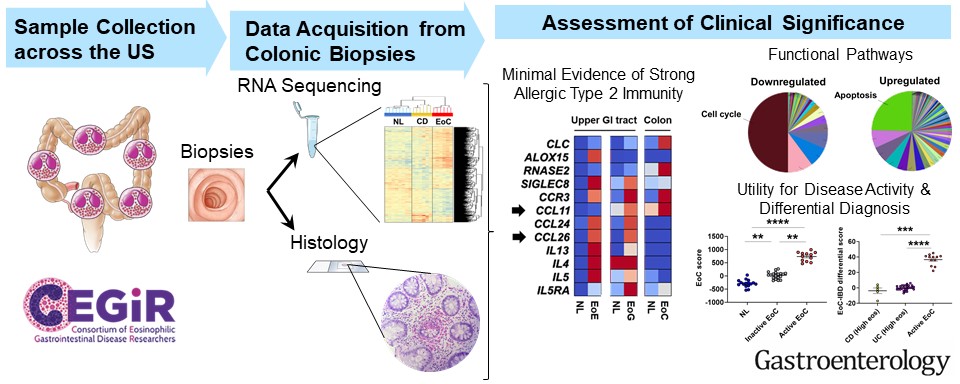Molecular Analysis Suggests Eosinophilic Colitis is a Unique Disease
Research By: Tetsuo Shoda, MD, PhD | Marc Rothenberg, MD, PhD
Post Date: January 26, 2022 | Publish Date: Jan. 24, 2022

The alphabet of eosinophilic diseases may be getting even longer with new findings from experts at Cincinnati Children’s indicating that eosinophilic colitis (EoC) is not a manifestation of other established gastrointestinal conditions but a disease of its own.
The study was based on analyzing samples from more than 60 people treated at multiple medical centers to compare this very rare disease to other conditions such as inflammatory bowel disease (IBD). Findings were published online Jan. 24, 2022, in Gastroenterology.
The research was led by first author Tetsuo Shoda, MD, PhD, and corresponding author Marc Rothenberg, MD, PhD, Director, Division of Allergy and Immunology at Cincinnati Children’s. Several other co-authors are based at Cincinnati Children’s while contributions also flowed from experts in San Diego, Chicago, Aurora, CO, and other locations.
What is EoC?
“Among eosinophilic gastrointestinal diseases (EGIDs), EoC represents the least frequent manifestation (1.6–2.1 per 100,000 persons) and least well-understood disorder. However, patients with EoC have a higher disease burden of symptoms and comorbidities than patients with eosinophilic esophagitis (EoE), the most common EGID. With the growing work in patients with EoE, nonesophageal EGIDs such as EoC have also become increasingly recognized in many populations across the world,” Shoda says.
Distinguishing EoC from other gastrointestinal conditions is important because treatments may differ. For example, some EGIDs can be managed with strict diets and anti–type 2 cytokine therapy. But IBD responds to biologics and anti-inflammatory therapies.

Study establishes an EoC transcriptome
The study found expression variations in 987 genes (i.e. EoC transcriptome) between those with EoC and those without the disease. The team also reported clear differences between other known EGIDs and with IBD at a molecular level. For example, the team developed a differential score that separates active EoC from IBD having high colonic eosinophil levels, a clinically challenging diagnosis.
The co-authors also suggest that EoC-caused tissue inflammation in the colon may involve processes distinct from other EGIDs “One of the most significant findings was unexpected-demonstrating that EoC is not related to strong allergic type 2 immunity,” Rothenberg says.
But more research is needed involving more patients to define diagnostic and treatment approaches for EoC.
Coordinated teamwork makes progress against rare diseases
Much of the way this study was conducted reflects a national, increasingly coordinated approach to analyzing the rarest diseases that affect children.
The people who provided sample tissues did so through medical centers participating in the Consortium of Eosinophilic Gastrointestinal Disease Researchers (CEGIR). This organization is headquartered at Cincinnati Children’s and includes 16 sites coast to coast. The data itself is stored by the Rare Diseases Clinical Research Network (RDCRN) Data Management and Coordinating Center, which has been managed by Cincinnati Children’s since 2020.
Funding sources for CEGIR include the National Institute of Health, the Campaign Urging Research for Eosinophilic Disease (CURED), Eosinophilic Family Coalition (EFC) and American Partnership for Eosinophilic Diseases (APFED).
| Original title: | Evaluating Eosinophilic Colitis as a Unique Disease using Colonic Molecular Profiles: A Multi-Site Study |
| Published in: | Gastroenterology |
| Publish date: | Jan. 24, 2022 |
Research By








